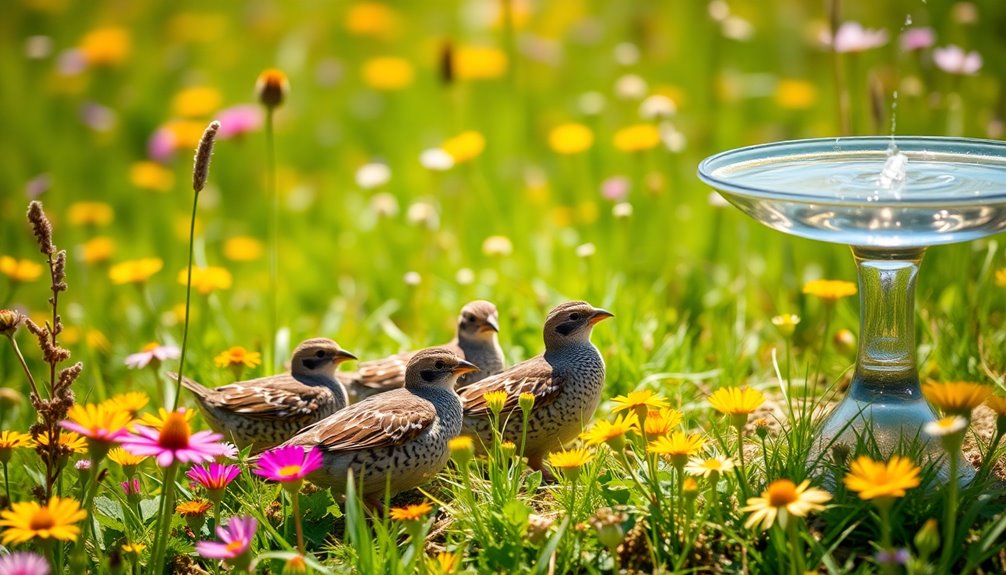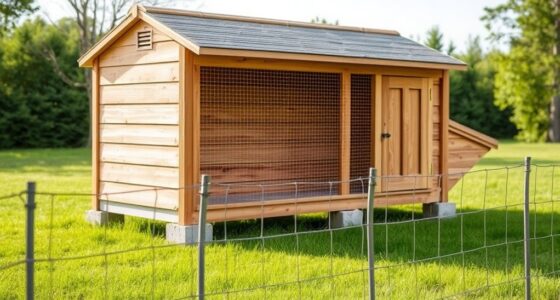Quail are quieter than many other birds, but they do make sounds that can be easily misunderstood. Male quail emit soft crowing during mating, while females chirp in distress. Their vocalizations can increase in stressful situations, so creating a calm environment helps minimize noise. With adequate space and a proper male-to-female ratio, you can better manage their sounds. Quail form strong social bonds, and their behavior also influences noise levels. If you're curious about how to create the perfect environment for your quail or their unique care needs, keep exploring to discover more insights.
Key Takeaways
- Quail produce minimal noise, often blending into their natural surroundings, making them quieter than many other birds.
- Male quail emit softer crowing sounds during mating, resembling songbirds rather than loud vocalizations.
- Female quail primarily chirp in distress, indicating their sensitivity to environmental changes and stress.
- Creating a quiet environment and maintaining a balanced male-to-female ratio can reduce excessive vocalizations.
- Familiarity with their surroundings and adequate space contributes to a sense of security, minimizing stress-related sounds.
Understanding Quail Vocalizations
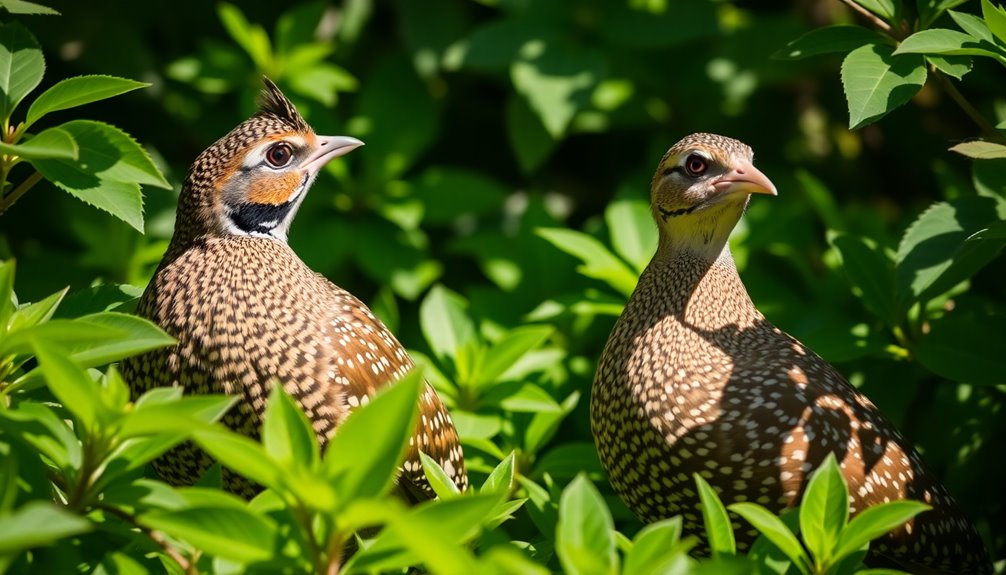
Understanding quail vocalizations can greatly enhance your experience with these unique birds. Quail produce minimal noise compared to other birds, blending softly into their natural surroundings.
Male quail emit softer crowing sounds during mating rituals, while female quail primarily chirp in distress. You'll notice that their noise levels increase when they're stressed or in new environments, highlighting their sensitivity.
To manage these sounds effectively, consider adjusting the male-to-female ratio in your flock; a ratio of 1 male to 4-6 females can reduce territorial calls from the males.
Additionally, ensuring familiarity with their environment and providing ample space can considerably lower anxiety-induced vocalizations, creating a quieter, more peaceful atmosphere in your quail coop.
Comparing Quail to Other Birds
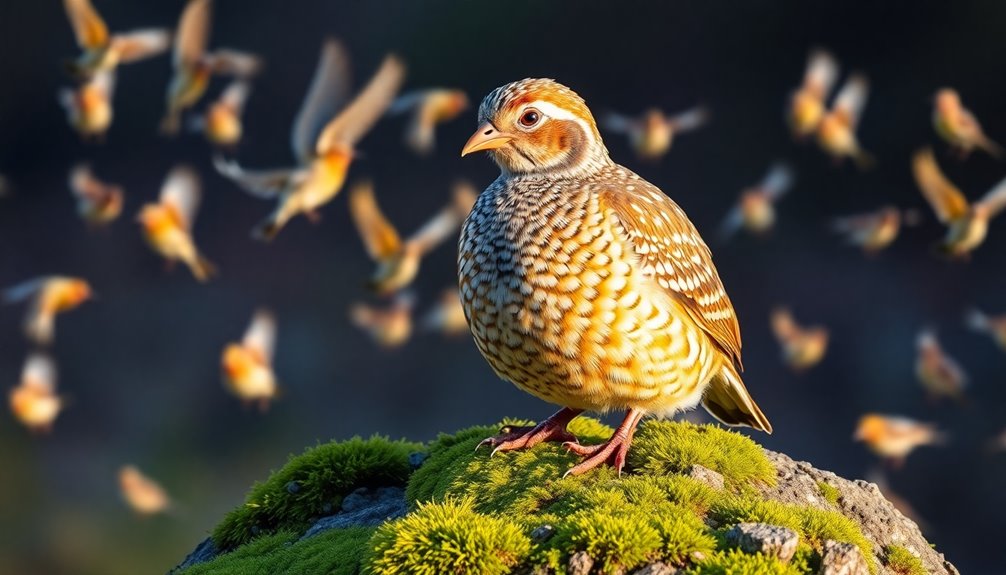
When you compare quail to other birds, you'll notice significant differences in noise levels, social behaviors, and space requirements.
Quail are much quieter than roosters or guinea fowl, making them ideal for urban environments.
Understanding these distinctions can help you appreciate why quail might be the perfect choice for your living situation.
Noise Levels Comparison
Quail are often celebrated for their quiet demeanor, especially when compared to more vocal birds like roosters and guinea fowl. Coturnix quail, in particular, produce minimal noise, making them an excellent option for those wanting game birds without the racket.
Male quail vocalize softly during the breeding season, resembling songbirds rather than the loud crows of roosters. Females chirp infrequently, usually only when distressed.
To further reduce noise levels, you can adjust the male-to-female ratio, ideally keeping one male for every four to six females. This strategy helps create a peaceful environment, blending their gentle sounds into the natural outdoor ambiance, ensuring you won't disturb neighbors in urban or suburban settings.
Social Behaviors Contrasted
While quail are known for their quiet nature, their social behaviors set them apart from many other bird species. They form strong bonds, especially between pairs, and show protective instincts. In contrast, some birds don't establish such close relationships. Quails can be skittish, making them less inclined to bond with humans, though gentle handling helps. They also exhibit mourning behavior after losing companions, reflecting emotional depth.
| Behavior Type | Quail |
|---|---|
| Social Bonds | Strong, especially among pairs |
| Communication | Soft vocalizations, mainly during mating |
| Territoriality | Less aggressive, with a pecking order |
Space Requirements Differentiation
Understanding space requirements is essential for successfully raising quail compared to other birds. Quail thrive in smaller, controlled environments, making them perfect for urban settings.
Here's what you need to know:
- Quail require approximately 1 square foot of space per bird, while chickens need about 4 square feet each.
- Unlike chickens, which need larger outdoor runs, quail should be housed in secure, predator-proof enclosures.
- Their enclosures must be well-ventilated and include ground cover like sand or straw, along with enrichment features to simulate their natural habitat.
This compact housing allows for higher stocking densities, enhancing productivity in limited spaces. Additionally, efficient use of space helps optimize the living conditions for quail, contributing to their overall health and productivity.
Common Misconceptions About Quail
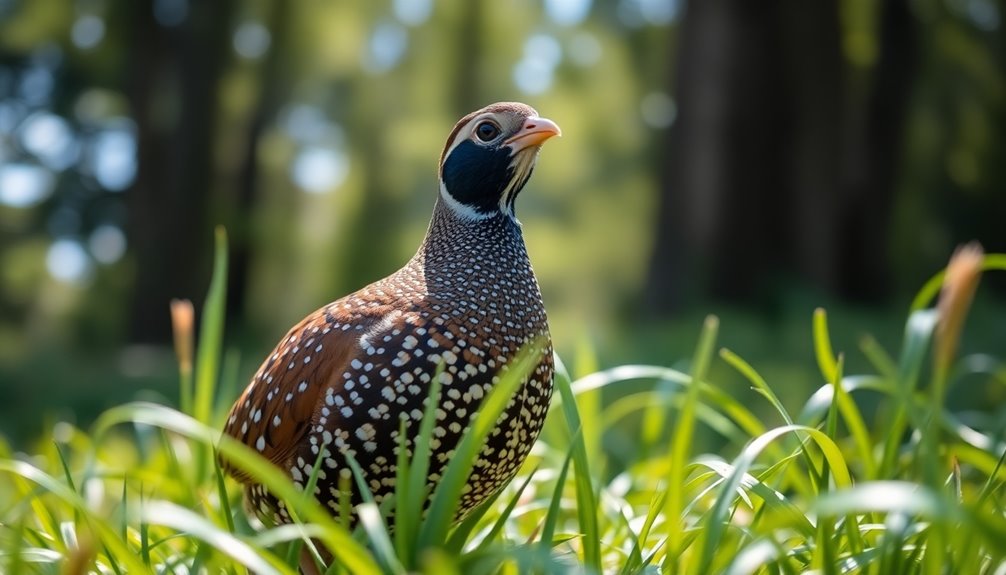
Many people assume that quail are noisy birds, but this couldn't be further from the truth. In reality, they produce minimal sounds, with gentle vocalizations that often blend into their natural surroundings.
While some think quail are silent, male quail do emit soft crowing sounds during mating, and females chirp when necessary. If you believe all quail are loud, consider that adjusting the male-to-female ratio in a flock can greatly reduce noise levels.
They mainly vocalize during breeding season or in response to stress. Contrary to the belief that they're disruptive pets, quail's quiet nature makes them ideal for urban living, ensuring their sounds won't disturb your neighbors.
Quail Behavior and Social Structures
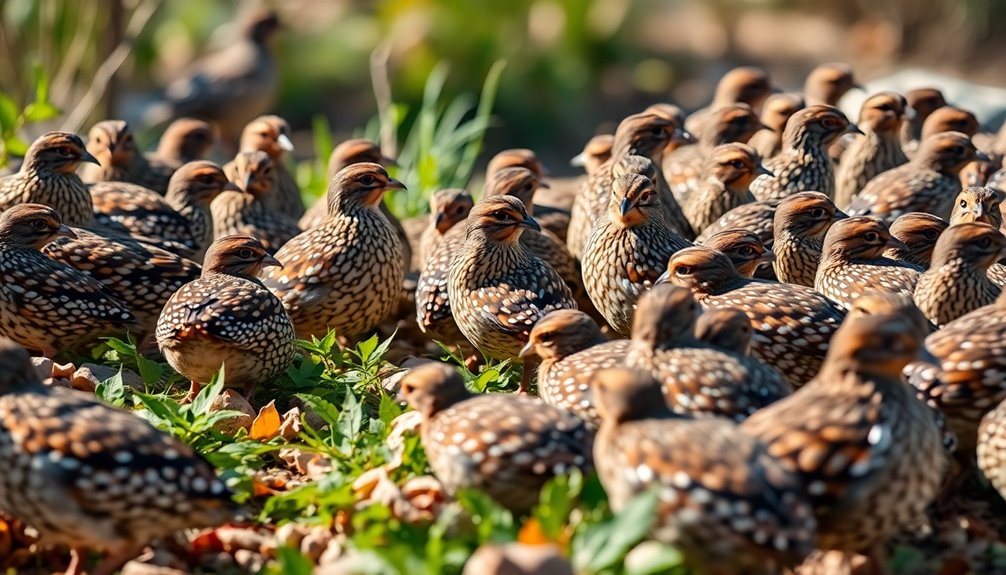
Quail are social creatures that thrive in flocks, forming strong bonds with one another, especially between males and females. Their behavior showcases their emotional depth, as they can grieve the loss of companions, displaying mourning behavior.
To better understand quail behavior and social structures, consider these key aspects:
- Communication: Quails use vocalizations and body language to express their emotional states, signaling stress or comfort to both their flock and humans.
- Aggression: They exhibit protective instincts, becoming aggressive when they perceive threats to their flock's safety.
- Individuality: Each quail has a distinct personality and communication style, influencing their interactions and dynamics within the group.
Recognizing these traits is essential for fostering a stable environment for your quail.
Managing Quail Noise Levels
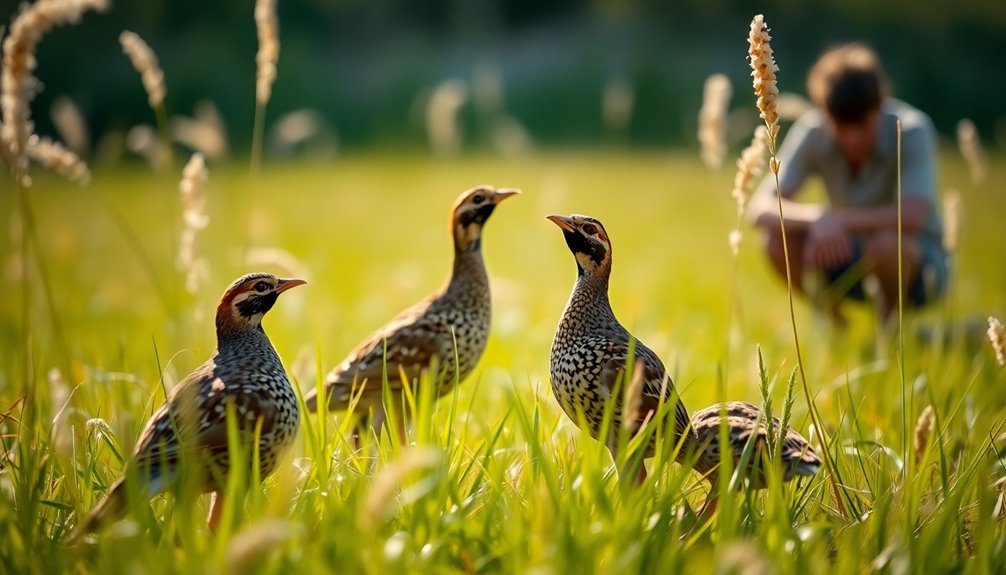
To manage noise levels among your quail, start by ensuring a balanced male-to-female ratio, ideally one male for every four to six females. Creating a comfortable environment and monitoring flock dynamics can also help reduce stress-induced vocalizations. Additionally, providing proper diet can contribute to overall well-being and reduce excessive calling.
Male-to-Female Ratio
Managing the male-to-female ratio in your quail flock is essential for keeping noise levels in check. Ideally, aim for a ratio of 1 male to 4-6 females. High male populations can lead to increased territorial vocalizations, making your flock noisier than you'd like.
Here are three effective strategies to maintain harmony:
- Separate males and females in different cages to minimize vocalizations, especially during mating rituals.
- Ensure ample space for your quails, as comfortable surroundings reduce anxiety-induced noise.
- Monitor flock dynamics regularly to identify vocalization triggers, allowing you to make adjustments as needed.
Environmental Comfort Strategies
Creating a peaceful environment for your quail flock is essential for minimizing noise levels. Start by maintaining a male-to-female ratio of 1 male to 4-6 females. This balance helps reduce territorial vocalizations that can disrupt your tranquility.
During mating season, consider separating males and females into different cages to further limit crowing.
Provide adequate space and enriching habitats with secure hiding spots to alleviate stress. When quail feel secure, they're less likely to make anxious noises.
Additionally, gradually acclimatizing them to their surroundings helps lower stress levels, fostering a calmer atmosphere. Moreover, incorporating mindfulness practices can also help in creating a serene space for both the quail and their caretakers.
Monitoring Flock Dynamics
Observing flock dynamics closely is essential for keeping noise levels in check among your quail. To manage noise effectively, consider these strategies:
- Maintain a male-to-female ratio of 1 male to 4-6 females. This balance minimizes territorial vocalizations from males.
- Separate males and females into different cages. This separation reduces vocalizations and creates a quieter environment.
- Provide ample space and comfort within their housing. Adequate space helps alleviate anxiety, which is a common trigger for increased vocalizations.
Regularly monitor interactions and stress levels in your flock. Familiarity with their surroundings can help your quail feel secure, ultimately leading to a calmer, quieter atmosphere.
Quail Care Requirements
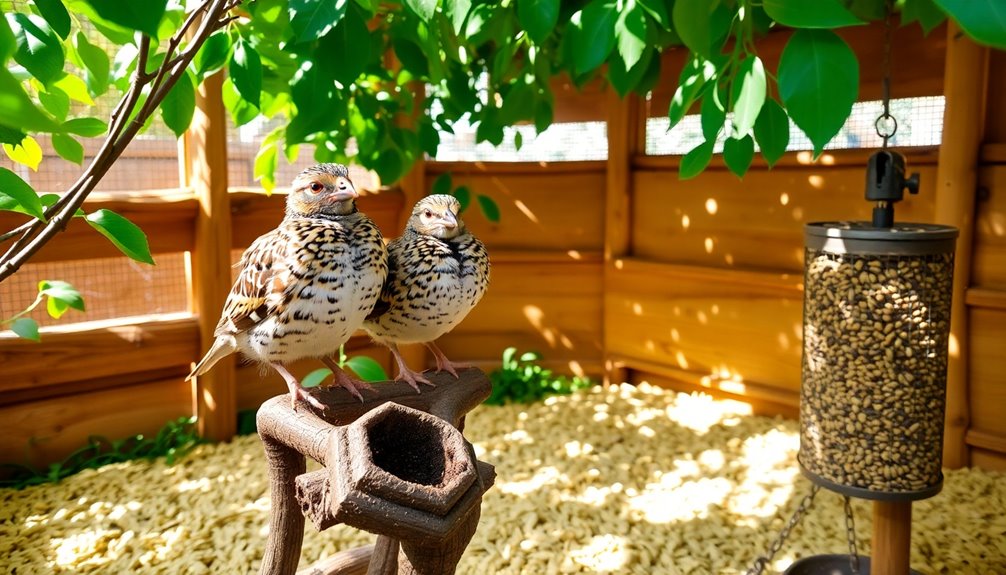
Caring for quail requires attention to their unique needs to guarantee they thrive.
First, provide secure, predator-proof housing with proper ventilation to shield them from threats and extreme temperatures.
Their diet should consist of 24–30% protein, essential for growth and health, which differs from chickens.
Regular gentle handling is vital; it helps reduce their flighty nature and promotes a calm temperament.
Quail do best in smaller environments with ground cover like sand or straw, allowing them to exhibit natural behaviors without requiring vast space.
Finally, maintain clean enclosures to prevent respiratory issues, ensuring a healthy living environment for these delicate birds.
Quail Egg Production Insights
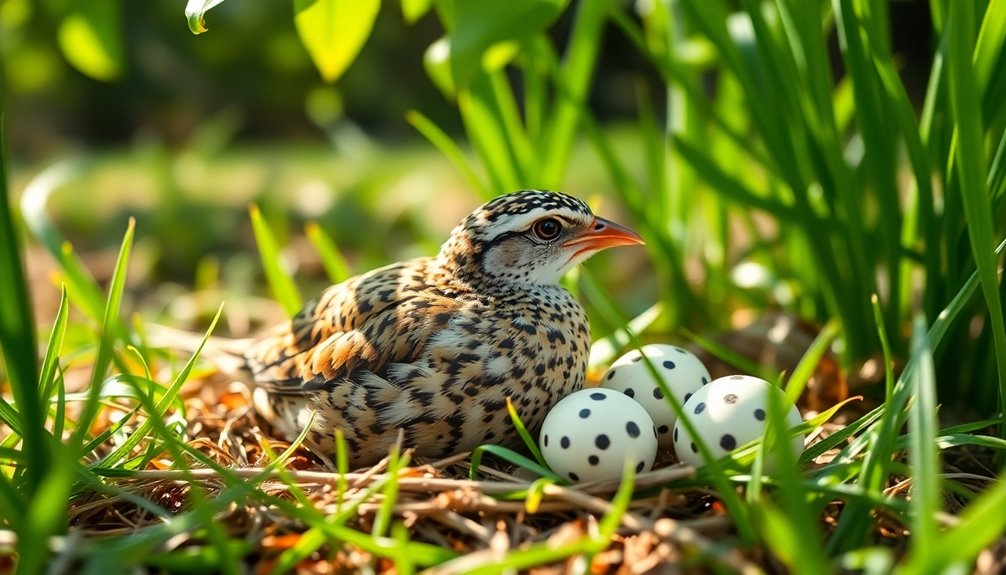
Quail egg production is impressive, with Coturnix quail laying up to 300 eggs per year, far exceeding the output of chickens relative to their size.
You'll appreciate that these quail typically start laying eggs at just 6–8 weeks of age, which is earlier than most chicken breeds.
While quail eggs are smaller, they offer a richer flavor and a higher yolk-to-white ratio, giving you a creamier texture.
Here are three key insights about quail eggs:
- Nutritional profile: Quail eggs often feature higher levels of certain vitamins.
- Culinary appeal: They're considered a delicacy, sought after in niche markets.
- Production efficiency: Their rapid egg-laying means you can enjoy a steady supply.
Profitability of Quail Farming
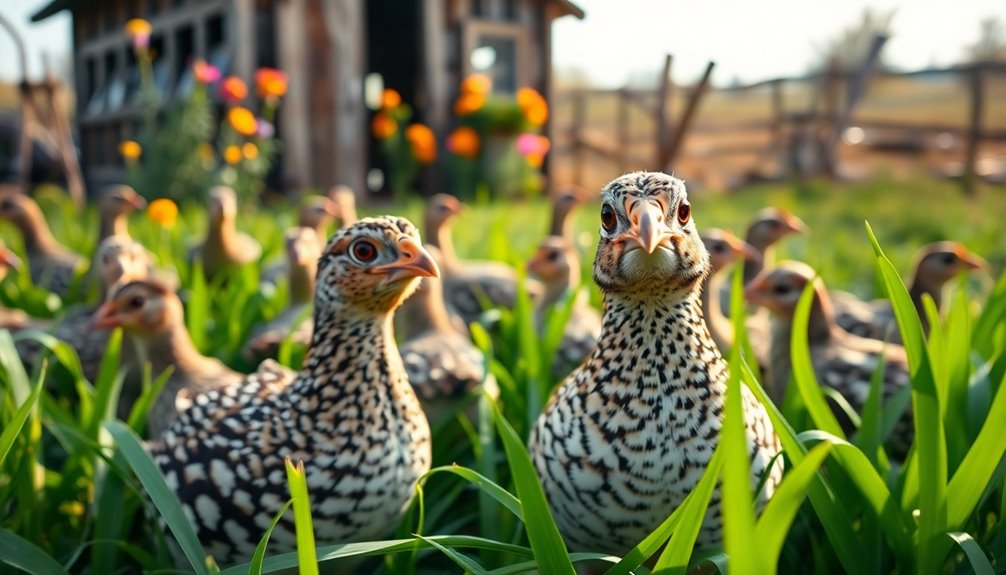
Farmers looking for a lucrative venture should consider quail farming, as it can yield impressive financial returns.
Coturnix quail can lay up to 300 eggs per year, providing a substantial production potential. Niche markets often pay high prices for quail eggs, making them a profitable product for small-scale farmers.
With low startup costs and quick production cycles, you can see a rapid return on your investment. Additionally, quail meat is a gourmet option that appeals to food enthusiasts, offering another revenue stream.
Don't forget about quail manure—it's a valuable organic fertilizer you can either sell or use in your own sustainable farming practices.
Resources for Quail Enthusiasts
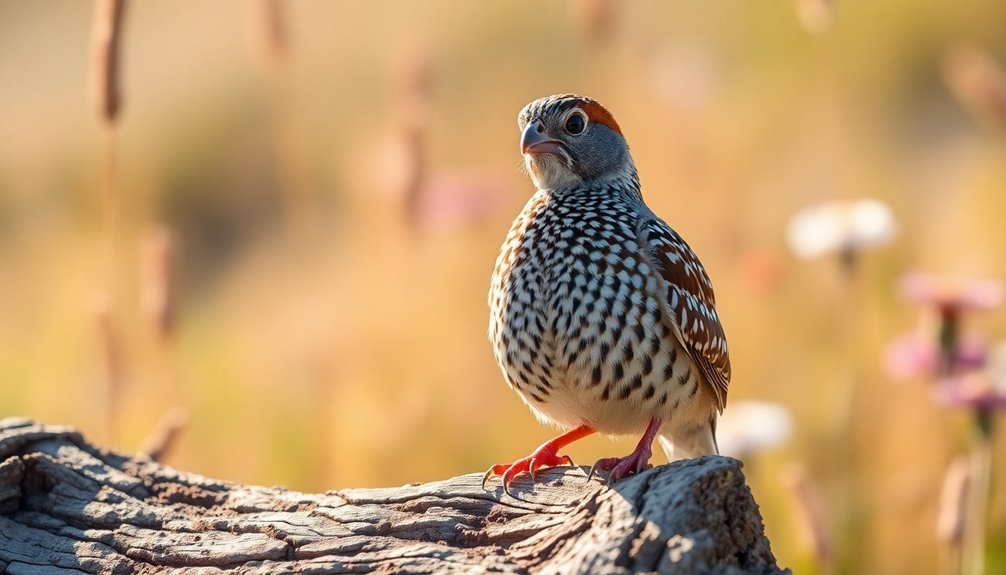
For those diving into the world of quail, a wealth of resources is available to enhance your experience. Understanding their vocal patterns and needs can help you create a peaceful environment.
Here are three key resources to take into account:
- Educational Blogs: Explore blogs dedicated to quail care. They often share insights on behavior and vocalizations, helping you manage your flock effectively.
- Community Forums: Join online communities where fellow enthusiasts share tips, experiences, and advice on noise management and flock ratios.
- Veterinary Guides: Consult veterinary resources focused on birds. They can provide valuable information on maintaining quail health and reducing stress-induced sounds.
With these resources, you'll be well-equipped to guarantee a quieter, happier quail habitat.
Frequently Asked Questions
Are Coturnix Quail Quiet?
Coturnix quail are generally quiet birds, producing soft vocalizations that blend into their surroundings.
You'll notice that male quail emit gentle crowing sounds primarily during mating, while females chirp infrequently.
Their overall noise levels are minimal, especially if you manage the male-to-female ratio effectively.
Can Quail Bond With Humans?
Yes, quail can bond with humans! When you handle them gently and regularly, they start to trust you, reducing their natural skittishness.
You'll notice that they can recognize familiar faces and respond to your presence, showcasing their social intelligence.
Each quail has its own personality, so some may be more receptive than others.
Just be patient, and create a safe environment to help them feel secure and form that special bond with you.
How Intelligent Are Quail?
Imagine a clever fox maneuvering through a maze, showcasing its wit and adaptability. Quail possess similar intelligence.
You'd see them solving problems, like covering their eggs with bedding, demonstrating their survival instincts. They can recognize familiar faces, forming bonds that reveal their social nature.
When a companion is lost, they express grief, highlighting emotional depth. So, next time you think of quail, remember their unique personalities and the intelligence that often goes unnoticed.
How Long Till Quail Are Fully Feathered?
Quail typically reach full feathering in about 4 to 6 weeks, depending on their care and environment.
During this time, you'll notice a significant transformation as downy plumage gradually gives way to feathers.
It's essential you provide them with a high-protein diet to support healthy development.
By monitoring their feather growth, you can assess their overall health and well-being, ensuring they thrive in their early life stages.
Conclusion
In the tapestry of avian life, quail weave a unique thread, often misunderstood for their vocal nuances. While they may not be the loudest singers in the bird choir, their charming calls add a delightful melody to the countryside. By debunking myths and understanding their behavior, you can truly appreciate these feathered friends. So, whether you're a potential farmer or a curious enthusiast, embrace the quail's quiet charm and let their story unfold in your world.

